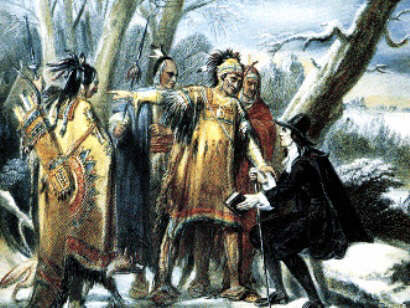The Narragansett Tribe was one of the more influential tribes in New England during the settlement of early Colonial America. The first European to make contact with them was Giovanni de Verrazzano in 1524. They interacted with the early colonies of Plymouth, Massachusetts Bay, Connecticut, and Rhode Island. They also participated in King Philip's War despite Roger Williams wanting them to stay neutral.

Jump to:
History
When Europeans made contact with the Native Americans, it quickly changed the balance of power throughout the region in various ways.
Some changes came through treaties, trade, and disease. The Narragansett benefited from all three, but especially the disease.
The Algonquian-speaking people along the eastern coast were ravaged by disease between 1616 - 1619, which weakened many of the tribes around the Narragansett.
One of the rival tribes was the Wampanoag tribe. The Wampanoag became allied with the colonists at Plymouth and used them to help shield their people from Narragansett attacks.
In the fall of 1621, the Narragansetts sent a sheaf of arrows wrapped in a snakeskin to Plymouth Colony as a threatening challenge, but Plymouth governor William Bradford sent the snakeskin backfilled with gunpowder and bullets. The Narragansetts understood the message and did not attack them.
European settlement in the Narragansett territory did not begin until 1635; in 1636, Roger Williams acquired land from Narragansett sachems Canonicus and Miantonomi and established Providence Plantations.
Pequot War: During the Pequot War of 1637, the Narragansetts allied with the New England colonists. However, the brutality of the colonists in the Mystic massacre shocked the Narragansetts, who returned home in disgust. After the Pequots were defeated, the colonists gave captives to their allies, the Narragansetts and the Mohegans.
The Narragansetts later had a conflict with the Mohegans over control of the conquered Pequot land. In 1643, Miantonomi led the Narragansetts in an invasion of eastern Connecticut, where they planned to subdue the Mohegans and their leader, Uncas.
Miantonomi had an estimated 1,000 men under his command. The Narragansett forces fell apart, and Miantonomi was captured and executed by Uncas' brother.
The following year, Narragansett war leader Pessicus renewed the war with the Mohegans, and the number of Narragansett allies grew.
The Mohegans were on the verge of defeat when the colonists came and saved them, sending troops to defend the Mohegan fort at Shantok. The colonists then threatened to invade Narragansett territory, so Canonicus and his son Mixanno signed a peace treaty. The peace lasted for the next 30 years.
King Philip's War: Metacomet subsequently declared war on the colonists in what the colonists called King Philip's War. Metacomet escaped an attempt to trap him in the Plymouth Colony, and the uprising spread across Massachusetts as other bands joined the fight, such as the Nipmuc. The Indians wanted to expel the colonists from New England. They waged successful attacks on settlements in Massachusetts and Connecticut, but Rhode Island was spared at the beginning, as the Narragansetts remained officially neutral.
The leaders of the 13 Original Colonies accused the Narragansetts of harboring Wampanoag refugees. They made a preemptive attack on the Narragansett Palisade fortress in Rhode Island on December 19, 1675, in a battle that became known as the Great Swamp Fight.
Hundreds of Narragansett men, women, and children perished in the attack and burning of the fort, but nearly all their warriors escaped. In January 1676, colonist Joshua Tefft was hanged, drawn, and quartered by colonial forces at Smith's Castle in Wickford, Rhode Island.
He had fought on the side of the Narragansetts during the Great Swamp Fight and was considered a traitor.
The Indians retaliated in a widespread spring offensive beginning in February 1676, in which they destroyed all Colonial settlements on the western side of Narragansett Bay. They burned Providence on March 27, 1676, destroying Roger Williams' house, among others.
Indians destroyed many towns throughout New England, and the attackers raided the suburbs of Boston. However, disease, starvation, battle losses, and the lack of gunpowder caused the Indian effort to collapse by the end of March.
Troops from Connecticut composed of the colonists and Mohegan allies swept into Rhode Island and killed substantial numbers of the now-weakened Narragansetts.
A force of Mohegans and Connecticut militia captured Narragansett sachem Canonchet a few days after the destruction of Providence, while a force of Plymouth militia and Wampanoags hunted down Metacomet.
He was shot and killed, ending the war in southern New England, although it dragged on for another year in Maine.
After the war, the English sold some surviving Narragansetts into slavery and shipped them to the Caribbean; others became indentured servants in Rhode Island.
The surviving Narragansetts merged with local tribes, particularly the Eastern Niantics. During the colonial and later times, tribe members intermarried with colonists and Africans. Their spouses and children were taken into the tribe, enabling them to keep a tribal and cultural identity.
First Great Awakening: During this time of revival in the colonies, many tribes were also introduced to Jesus. The Narragansetts were heavily influenced by the awakening. The colonists built a church for the tribe, and they were able to hold onto the church and the land for quite a while.
The Civil War: Due to the Indian treaties, the tribe was able to stay neutral during the Civil War. If they had participated, they would have had to give up their status as a separate Indian nation.
20th Century: The Narragansetts lost control of much of their tribal lands during the state's late 19th-century detribalization, but they kept a group identity. The tribe was incorporated in 1900 and built their longhouse in 1940 as a traditional place for gatherings and ceremonies.
